Summer is coming and it’s time to start thinking about making more use of your garden spaces. If you are fortunate enough to have a large outdoor area to work with then you’ll have location options. Finding the right one is all dependant on when and where the sunlight hits your garden, and if you would prefer the sunrise or the sunset.
You might find this space is not right outside the back of your house.
“The amount of clients I go to meet, and they’d have a big patio terrace out the back of their house. We’d be standing chatting and I’d notice there’d be a furniture set over in the back right hand corner on the grass,” explains Alan Rudden, Bloom award winning Dublin garden designer.
“I ask, what’s that furniture set in the background? And they say that’s where the sun is. That’s where they go to catch the sun,” he says.
“This is what they should be looking at - putting in a smaller area close to the house and having their main entertainment seating area in the sunny spot.”
Budget
All projects are dictated by your budget but even if you have only a small budget you can still create a pleasant seating area outside of your home. It doesn’t have to break the bank; just work within the measures you can afford.
“I know the French are great at just using grass spaces, for their eating out,” says Betty Kehoe, garden landscaper/designer at Aisling Designs, her family business in Co Wexford.
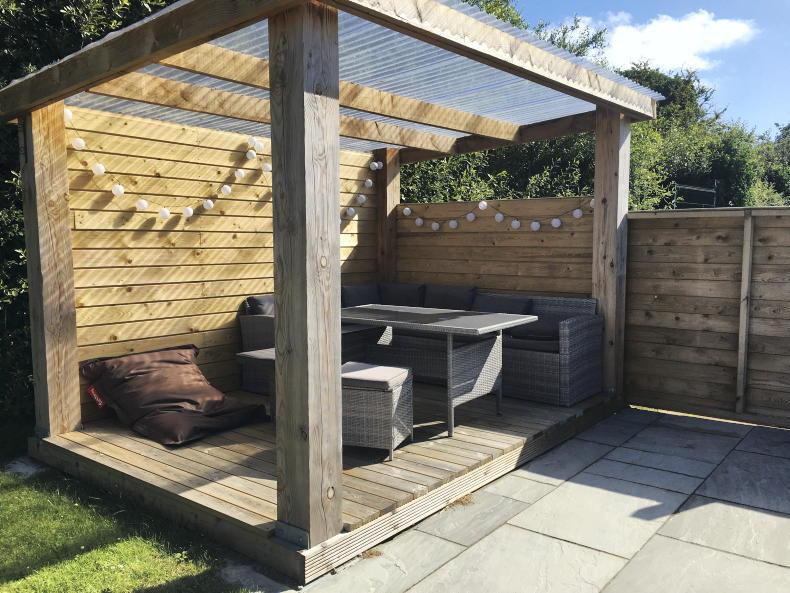
Betty Kehoe from Aisling Designs & Landscapes built this pergola about four years ago.
“Let the grass grow right up to the house, just mow when you’re about to put your outdoor furniture there and lash away.”
“Consider budgets - what you want to spend on the space and what you don’t want to spend on the space. There is no set rule,” she adds.
Choosing a base
As Betty has just mentioned there is no reason you can’t just create a seating area on grass if your budget is tight. But for those who are looking for a raised patio then choosing what you would like under foot is going to make or break (quite literally) your patio area.
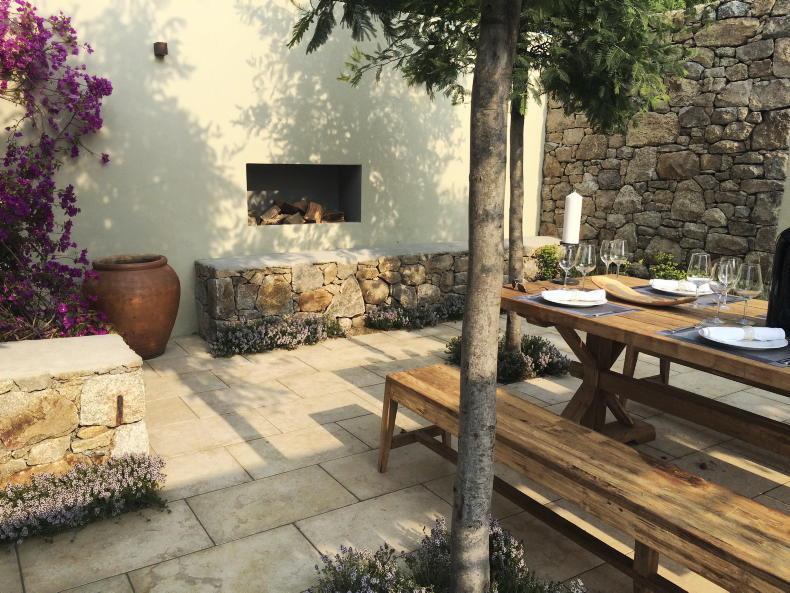
A concrete or tile base is better than wood for your patio.
Neither Betty nor Alan recommend wooden decking, this is where the ‘break’ comes in. Irish weather and wooden decking can result in a nasty fall when it becomes slippery underfoot - bear that in mind if you are going down the decking route. Try the alternative composite material made from recycled materials which is less slippery in wet conditions.
“If you want to be totally safe, you’d go with something like a natural stone like a granite or limestone,” says Alan. “Sandstone is too porous a product for Ireland.”
Another alternative is porcelain which will give you more options in the colour department. Betty points out to make sure you are using an outdoor rated anti slip porcelain product. Indoor tiles won’t cut it.
Outdoor furniture
First up, if possible don’t go cheap. You need your furniture to last and I’m sure we don’t need to mention the ‘Irish elements’ again.
“The main thing is quality,” says Alan. “If you are going for outdoor furniture invest heavily in it and go for quality. Longevity is the most important thing.”
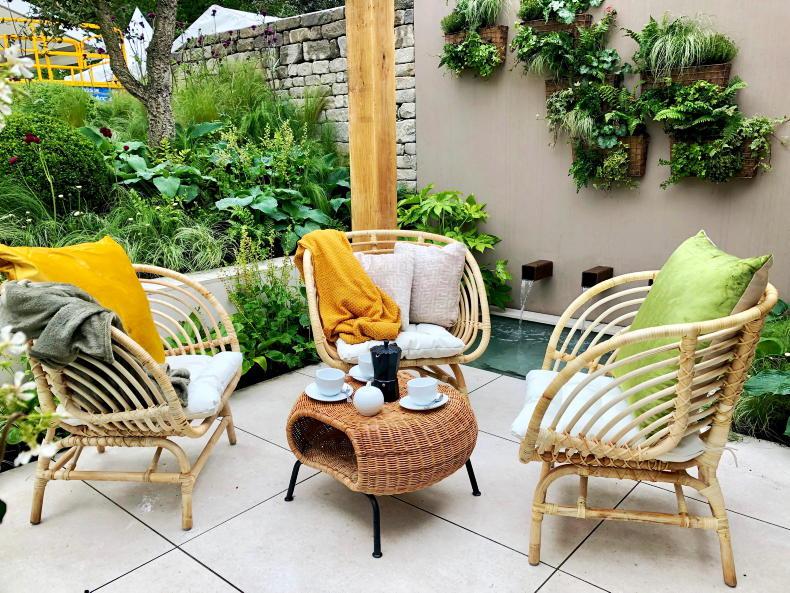
If your budget can allow, do not opt for cheap garden furniture.
For those rather windy spots Betty suggests going heavy. “You can get granite tables and benches, or there is composite plastic furniture that you can get now, it’s really heavy and made from waste plastic,” she says.
Those tight on space can incorporate seating spaces into their walled areas.
Lighting
Solar lighting has improved massively over the years so it should not be overlooked. It’s easily moved around the garden too. Alan, however, tends to use lighting from the grid.
“We’d use atmospheric lighting – spotlights on plants and trees,” he says. “Then we’d also have practical lighting which would be LED strips on the likes of steps.”
“Lighting is extremely important because you are creating a view from your house. You might not necessarily be in your garden, but you want to be able to look out at it,” he adds.
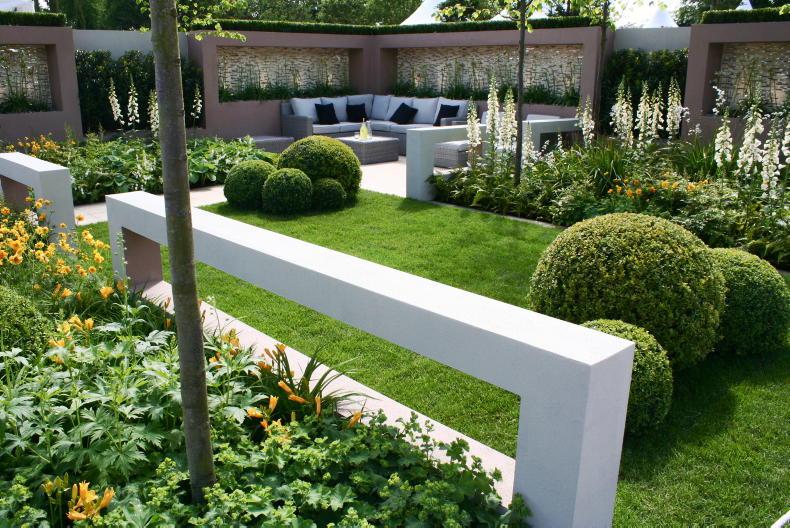
Patio plants
At the end of the day plants are the most important part of any patio area, after all you are creating an ‘outdoor room’ within your garden. And there are plenty of options. Alan gives us a few things to consider when choosing your plants for your patio area.
The plants create the backdrop to the area.Planted trees can break up a space and define areas – take a look at olive trees or hawthorn. Get them in the ground if you have the space to do it.If you can’t get plants in the ground, there are a lot of plants which will grow in raised planters quite happily. You can knit some edible plants though your planting scheme – use herbs like rosemary.Climbing plants can add to walls or pergolas. Great climbers to use, that won’t take over your garden, are Star Jasmine, Wisteria (an elegant climber for a pergola) and Hydrangea Petiolaris (loves a dark shaded wall where nothing else will grow).Invest in a vertical wall. You can buy a series of pots which hang on your wall, and they are all fed into each other with an irrigation system. They are great for biodiversity and can be watered from a reservoir of collected rainwater. A checklist to the perfect patio
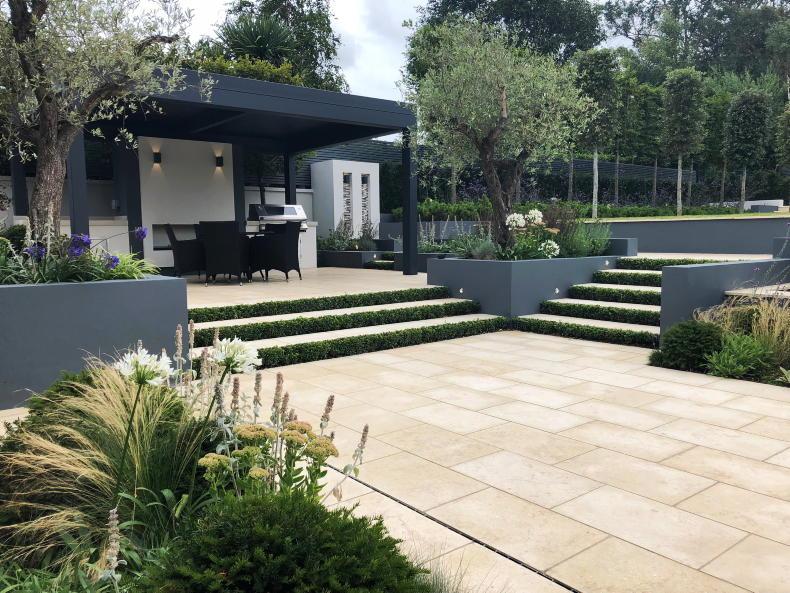
Betty Kehoe gives us a quick checklist of points to consider when planning out your perfect patio area. Whether it is right outside your patio doors or a space further down the garden you’ll need to consider the following in you plans.
Consider the position of your patio and when you’re going to use it. Do you want the sunrises or sunsets? The actual aspect of the positioning of it is really important.Decide you budget, you have to be realistic. If you have a small budget, you can still have a patio. Something as simple as hardcore with a bit of gravel on top. Maybe in a year or two some budget will free up and you can add paving.Look at the interior of your house. If you’re building a new house, and you want this fabulous outside room to be part of your house, don’t do it in isolation from the decor of your interior. Don’t create big paved areas, without softening them with planting or breaking them somehow. You could use a different material like beach cobble. Areas of beach cobble can look really nice to break a monotonous concrete patio. Plants can completely transform a patio.Shelter – you don’t always need a big screen of planting; you can drop the level of your patio. You will only need to go down about 50cm. You can even do some soil mounding around the patio which will give some shelter as well.Right plant, right place – invest time into getting the right plants for your space. Less is more, don’t overdo it. Just keep everything simple. Read more
Living Life: The Self-Sufficient Garden
On the wild side
Summer is coming and it’s time to start thinking about making more use of your garden spaces. If you are fortunate enough to have a large outdoor area to work with then you’ll have location options. Finding the right one is all dependant on when and where the sunlight hits your garden, and if you would prefer the sunrise or the sunset.
You might find this space is not right outside the back of your house.
“The amount of clients I go to meet, and they’d have a big patio terrace out the back of their house. We’d be standing chatting and I’d notice there’d be a furniture set over in the back right hand corner on the grass,” explains Alan Rudden, Bloom award winning Dublin garden designer.
“I ask, what’s that furniture set in the background? And they say that’s where the sun is. That’s where they go to catch the sun,” he says.
“This is what they should be looking at - putting in a smaller area close to the house and having their main entertainment seating area in the sunny spot.”
Budget
All projects are dictated by your budget but even if you have only a small budget you can still create a pleasant seating area outside of your home. It doesn’t have to break the bank; just work within the measures you can afford.
“I know the French are great at just using grass spaces, for their eating out,” says Betty Kehoe, garden landscaper/designer at Aisling Designs, her family business in Co Wexford.

Betty Kehoe from Aisling Designs & Landscapes built this pergola about four years ago.
“Let the grass grow right up to the house, just mow when you’re about to put your outdoor furniture there and lash away.”
“Consider budgets - what you want to spend on the space and what you don’t want to spend on the space. There is no set rule,” she adds.
Choosing a base
As Betty has just mentioned there is no reason you can’t just create a seating area on grass if your budget is tight. But for those who are looking for a raised patio then choosing what you would like under foot is going to make or break (quite literally) your patio area.

A concrete or tile base is better than wood for your patio.
Neither Betty nor Alan recommend wooden decking, this is where the ‘break’ comes in. Irish weather and wooden decking can result in a nasty fall when it becomes slippery underfoot - bear that in mind if you are going down the decking route. Try the alternative composite material made from recycled materials which is less slippery in wet conditions.
“If you want to be totally safe, you’d go with something like a natural stone like a granite or limestone,” says Alan. “Sandstone is too porous a product for Ireland.”
Another alternative is porcelain which will give you more options in the colour department. Betty points out to make sure you are using an outdoor rated anti slip porcelain product. Indoor tiles won’t cut it.
Outdoor furniture
First up, if possible don’t go cheap. You need your furniture to last and I’m sure we don’t need to mention the ‘Irish elements’ again.
“The main thing is quality,” says Alan. “If you are going for outdoor furniture invest heavily in it and go for quality. Longevity is the most important thing.”

If your budget can allow, do not opt for cheap garden furniture.
For those rather windy spots Betty suggests going heavy. “You can get granite tables and benches, or there is composite plastic furniture that you can get now, it’s really heavy and made from waste plastic,” she says.
Those tight on space can incorporate seating spaces into their walled areas.
Lighting
Solar lighting has improved massively over the years so it should not be overlooked. It’s easily moved around the garden too. Alan, however, tends to use lighting from the grid.
“We’d use atmospheric lighting – spotlights on plants and trees,” he says. “Then we’d also have practical lighting which would be LED strips on the likes of steps.”
“Lighting is extremely important because you are creating a view from your house. You might not necessarily be in your garden, but you want to be able to look out at it,” he adds.

Patio plants
At the end of the day plants are the most important part of any patio area, after all you are creating an ‘outdoor room’ within your garden. And there are plenty of options. Alan gives us a few things to consider when choosing your plants for your patio area.
The plants create the backdrop to the area.Planted trees can break up a space and define areas – take a look at olive trees or hawthorn. Get them in the ground if you have the space to do it.If you can’t get plants in the ground, there are a lot of plants which will grow in raised planters quite happily. You can knit some edible plants though your planting scheme – use herbs like rosemary.Climbing plants can add to walls or pergolas. Great climbers to use, that won’t take over your garden, are Star Jasmine, Wisteria (an elegant climber for a pergola) and Hydrangea Petiolaris (loves a dark shaded wall where nothing else will grow).Invest in a vertical wall. You can buy a series of pots which hang on your wall, and they are all fed into each other with an irrigation system. They are great for biodiversity and can be watered from a reservoir of collected rainwater. A checklist to the perfect patio

Betty Kehoe gives us a quick checklist of points to consider when planning out your perfect patio area. Whether it is right outside your patio doors or a space further down the garden you’ll need to consider the following in you plans.
Consider the position of your patio and when you’re going to use it. Do you want the sunrises or sunsets? The actual aspect of the positioning of it is really important.Decide you budget, you have to be realistic. If you have a small budget, you can still have a patio. Something as simple as hardcore with a bit of gravel on top. Maybe in a year or two some budget will free up and you can add paving.Look at the interior of your house. If you’re building a new house, and you want this fabulous outside room to be part of your house, don’t do it in isolation from the decor of your interior. Don’t create big paved areas, without softening them with planting or breaking them somehow. You could use a different material like beach cobble. Areas of beach cobble can look really nice to break a monotonous concrete patio. Plants can completely transform a patio.Shelter – you don’t always need a big screen of planting; you can drop the level of your patio. You will only need to go down about 50cm. You can even do some soil mounding around the patio which will give some shelter as well.Right plant, right place – invest time into getting the right plants for your space. Less is more, don’t overdo it. Just keep everything simple. Read more
Living Life: The Self-Sufficient Garden
On the wild side






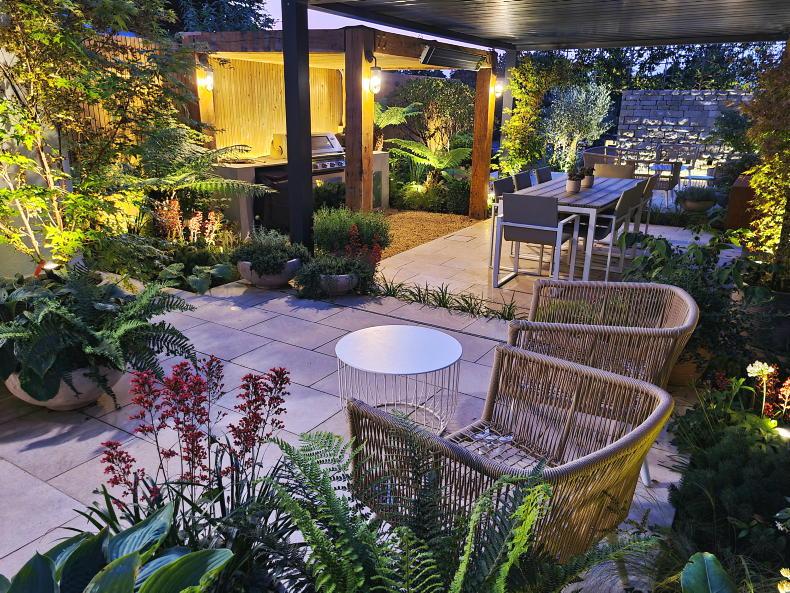




 This is a subscriber-only article
This is a subscriber-only article









SHARING OPTIONS: